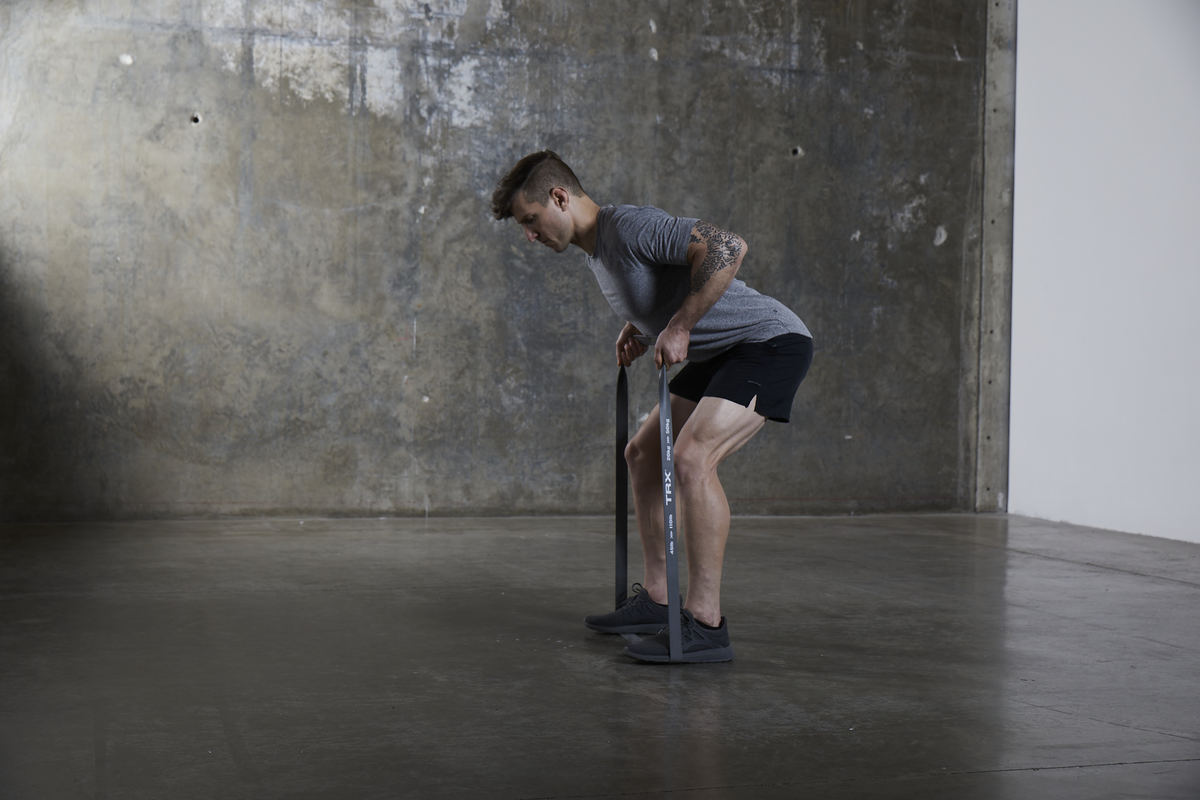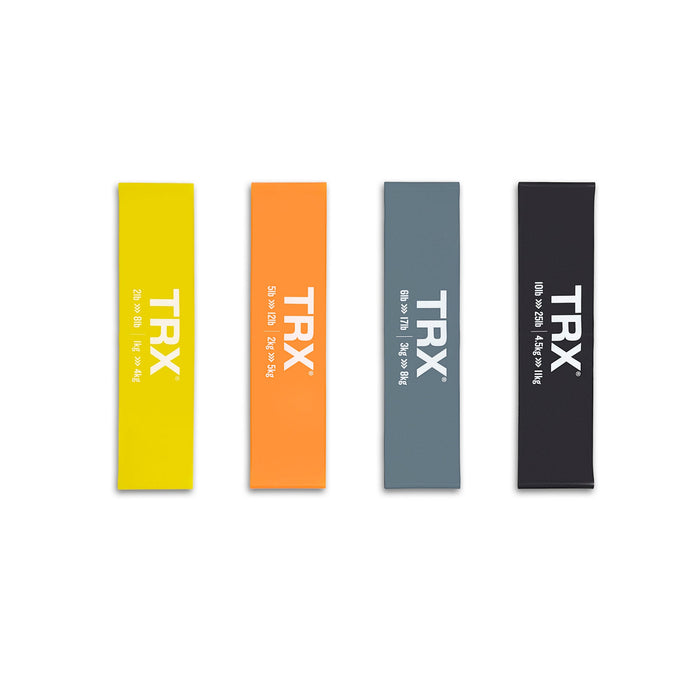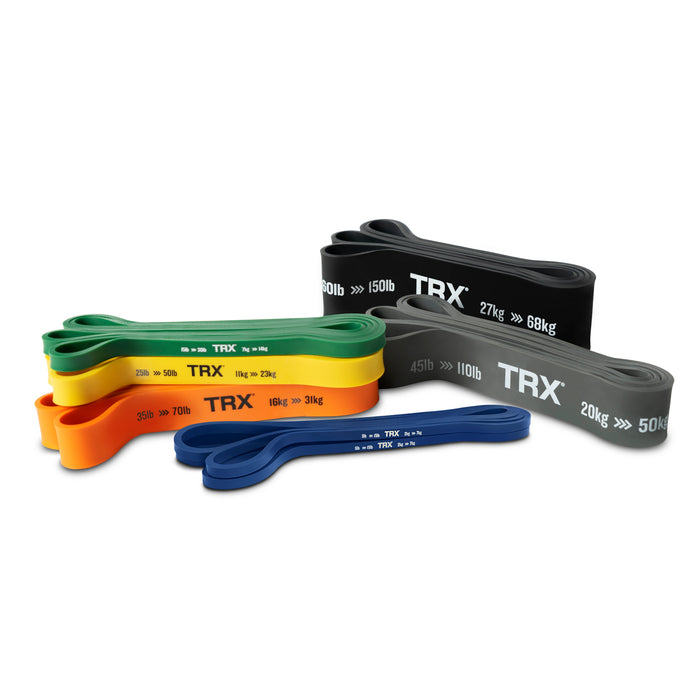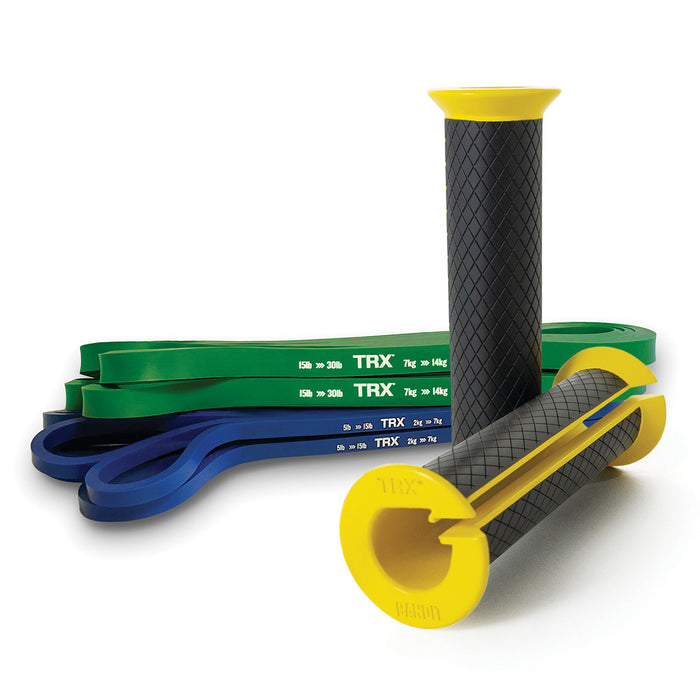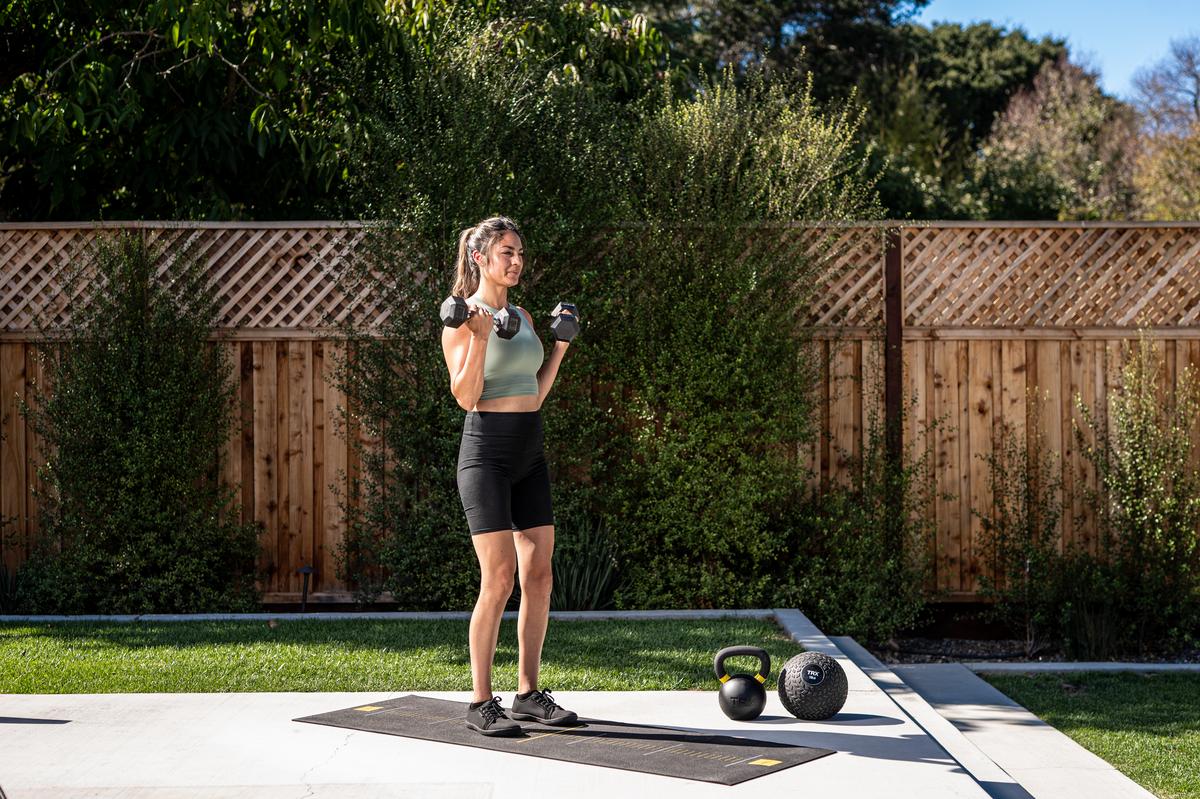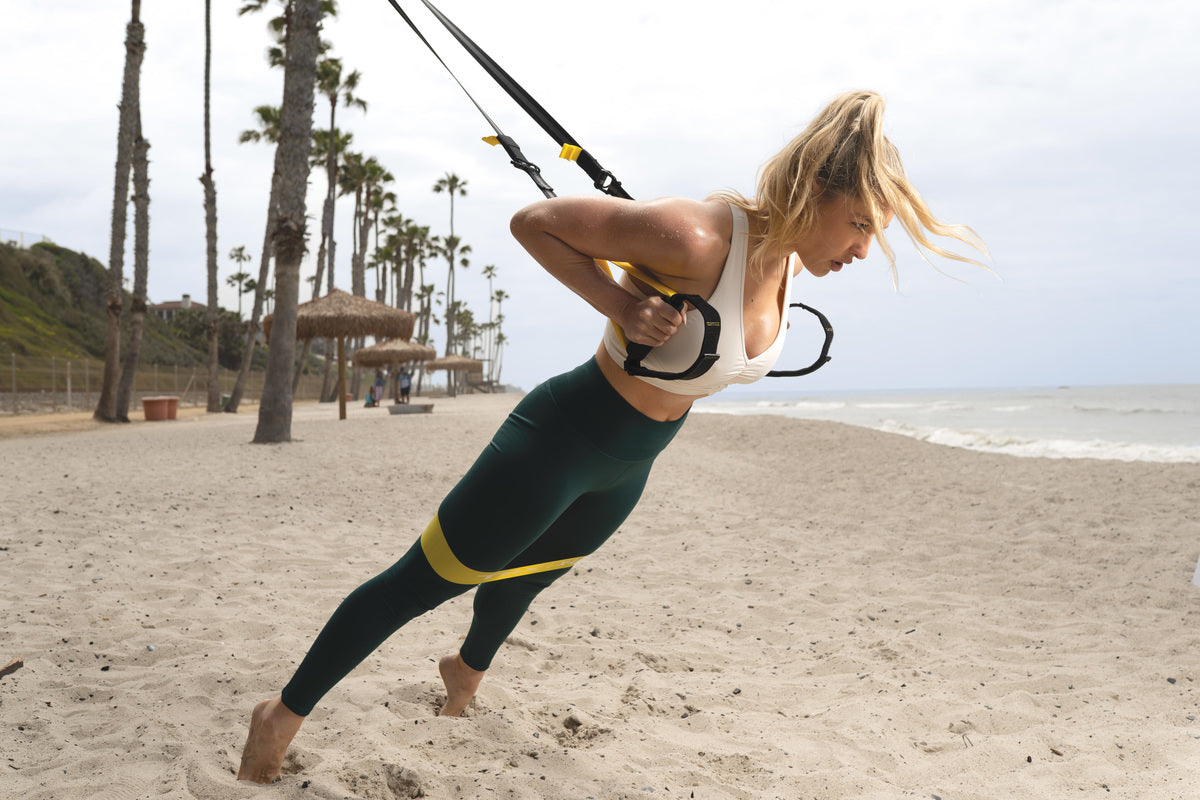When people think about exercising their back, they typically think of weight training. This isn’t wrong, but resistance bands are just as effective yet underutilized by most individuals. Today, we’re going to show you the best resistance band back exercises you can add to your arsenal.
We’ll also answer some commonly-asked questions and leave you with a sample workout that you can try anywhere today. Let’s get started!
Benefits of Using Resistance Bands
Resistance bands offer a multitude of benefits that make them a fantastic addition to any workout routine. Here are five key advantages that make resistance bands a must-have fitness tool:
- Versatility: Resistance bands provide a wide range of exercises targeting various muscle groups. From upper body to lower body, they offer endless possibilities for strength training, flexibility, and even rehabilitation exercises.
- Portability: One of the greatest advantages of resistance bands is their portability. They are lightweight, compact, and easily fit into a gym bag or suitcase, allowing you to take your workout anywhere. For example, you can get a resistance band arm workout in while on vacation, but you can’t do the same with dumbbells unless there’s a gym where you’re going. Whether you're at home, traveling, or even outdoors, resistance bands provide a convenient and effective workout solution.
- Adjustable Resistance: With resistance bands, you can easily adjust the level of resistance to match your fitness level. Whether you're a beginner or an experienced athlete, resistance bands offer different tension levels, allowing you to progressively increase the resistance as you get stronger.
- Joint-Friendly: Resistance bands provide a more accommodating resistance, meaning the tension increases as the band is stretched. This can be advantageous for individuals with joint issues or those recovering from injuries, as it allows for a potentially more joint-friendly workout. Dumbbells, on the other hand, can place more stress on the joints due to the constant load they provide.
- Functional Training: Resistance bands promote functional training by mimicking real-life movements and engaging multiple muscle groups simultaneously. This helps improve overall coordination, balance, and stability, which are essential for daily activities and sports performance.
Can You Get a Good Workout from Resistance Bands?
Absolutely! Resistance bands are an excellent tool for getting a full-body workout and achieving significant fitness gains. Despite their simple appearance, resistance bands provide resistance through the stretch and tension of elastic bands.
The resistance increases as you stretch the band further, challenging your muscles and promoting strength and endurance.
With the ability to target various muscle groups and adjust the resistance level, training with elastic resistance offer a versatile and effective workout experience. Whether you're aiming to build muscle, increase flexibility, improve stability, or engage in rehabilitation exercises, resistance bands can deliver a challenging and rewarding workout that helps you achieve your fitness goals.
If you don't have any type of resistance band equipment, pick one up today.
Try These Resistance Band Back Exercises Today
12. Single-Arm Rows
Elevate your single-arm row exercise to new heights with the remarkable benefits of using a resistance band. Using a band provides targeted and balanced strength development for each side of your back, ensuring optimal muscle engagement and reducing any strength imbalances. Additionally, the variable resistance offered by the band challenges your muscles throughout the entire range of motion, promoting greater muscle activation and enhancing your overall strength gains.
- Start by securing the resistance band around a sturdy anchor point at waist height.
- Stand facing the anchor point and hold the band handle or band end with one hand.
- Take a few steps back to create tension in the band, ensuring there is no slack.
- Position yourself with a slight forward lean, keeping your back straight and core engaged.
- Begin the exercise by pulling the band handle towards your body, retracting your shoulder blade, and squeezing your back muscles.
- Focus on maintaining a controlled and smooth movement throughout the exercise, avoiding any jerking or swinging motions.
- Pause for a brief moment at the top of the movement, feeling the contraction in your back muscles.
- Slowly release the tension and return to the starting position with control.
- Repeat for the desired number of reps.
11. Trap Raises
If you're looking to target and strengthen your trapezius muscles, trap raises aka shoulder shrugs, with a resistance band are a game-changer. This exercise specifically focuses on the upper back and shoulder region, helping you develop strong and defined traps. By incorporating trap raises into your workout routine, you can improve your posture, enhance shoulder stability, and add an impressive dimension to your upper body strength.
- Begin by stepping on the resistance band with both feet, shoulder-width apart.
- Grasp the handles or ends of the resistance band with an overhand grip.
- Stand tall with a slight bend in your knees and engage your core for stability.
- Keep your arms extended downward, palms facing your body, and maintain a neutral spine.
- Initiate the movement by contracting your traps and raising your shoulders upward towards your ears.
- Hold the peak contraction for a brief moment, focusing on squeezing your traps.
- Slowly lower your shoulders back down to the starting position, maintaining control throughout the movement.
- Repeat for the desired number of reps.
10. Straight-Arm Lat Pulldown
Using a resistance band for straight arm lat pulldowns offers the benefit of adjustable resistance levels, allowing for progressive overload and customization based on individual strength. Additionally, bands engage stabilizing muscles and require core activation, resulting in improved balance and functional strength compared to machine-based exercises.
- Begin by securing the resistance band above you, making sure it is attached to a sturdy anchor point.
- Stand facing the anchor point with your feet shoulder-width apart.
- Grab the resistance band with both hands using an overhand grip, keeping your arms straight.
- Take a step or two back to create tension in the band, ensuring there is no slack.
- Position yourself with a slight forward lean and engage your core for stability.
- Initiate the movement by engaging your lats and pulling the resistance band downward towards your thighs.
- Keep your arms straight throughout the exercise, focusing on using your back muscles to perform the movement.
- Squeeze your lats at the bottom of the movement, emphasizing the contraction in your back.
- Slowly release the tension and return to the starting position with control, maintaining proper form.
- Repeat for the desired number of reps.
9. Bent-over Row
The bent-over row with a resistance band is a phenomenal exercise for building a stronger and more defined back. By incorporating this movement into your routine, you can target multiple muscle groups in your upper back, including the lats, rhomboids, and rear delts. The bent-over row with a resistance band not only helps you develop a powerful back but also improves posture and enhances functional strength.
- Begin by placing the resistance band under your feet and positioning your feet shoulder-width apart.
- Hold the band handles or ends with an overhand grip, palms facing your body.
- Bend your knees slightly and hinge forward at the hips, maintaining a neutral spine.
- Keep your back straight and engage your core for stability throughout the exercise.
- Initiate the movement by pulling the resistance band toward your lower abdomen, leading with your elbows.
- Squeeze your shoulder blades together and focus on contracting your back muscles at the top of the movement.
- Slowly release the tension and return to the starting position, maintaining control throughout.
- Repeat for the desired number of reps.
- Avoid rounding your back or using momentum to perform the exercise.
8. Reverse Fly
The reverse fly with a resistance band not only enhances your upper body strength but also aids in shoulder stability and mobility.
- Begin by standing with your feet shoulder-width apart and positioning the resistance band under your feet.
- Hold the band handles or ends with an overhand grip, palms facing each other.
- Soften your knees slightly and hinge forward at the hips, maintaining a flat back and engaging your core.
- Start with your arms extended in front of you, keeping a slight bend in your elbows.
- Initiate the movement by squeezing your shoulder blades together and pulling the band apart.
- Focus on engaging your upper back muscles and maintaining a controlled motion throughout the exercise.
- Open your arms until they are in line with your shoulders, feeling the contraction in your rear deltoids and upper back.
- Slowly release the tension and return to the starting position, maintaining form and control.
- Repeat for the desired number of reps.
7. Band Pull-Aparts
Band pull-apart with a resistance band offers a versatile and accessible way to enhance your upper body strength, correct postural imbalances, and develop a more well-rounded physique.
- Begin by holding the resistance band with both hands, gripping it slightly wider than shoulder-width apart.
- Stand with your feet hip-width apart and keep a slight bend in your knees.
- Extend your arms straight out in front of you, shoulder-width apart, with the resistance band at chest level.
- Engage your core and maintain a tall, upright posture throughout the exercise.
- Initiate the movement by pulling the band apart, focusing on squeezing your shoulder blades together.
- Continue pulling the band until your arms are fully extended out to the sides, creating tension in the band.
- Hold the peak contraction briefly, feeling the activation in your upper back muscles.
- Slowly release the tension and bring your arms back to the starting position in a controlled manner.
- Repeat for the desired number of reps.
6. Face Pulls
The face pulls with a resistance band not only help you develop a balanced and strong upper body but also aid in preventing and rehabilitating shoulder injuries.
- Start by attaching the resistance band to a secure anchor point at chest height.
- Stand facing the anchor point and hold the band handles or ends with an overhand grip.
- Take a few steps back to create tension in the band, ensuring there is no slack.
- Stand with your feet shoulder-width apart and maintain a slight bend in your knees.
- Start with your arms extended in front of you, palms facing downward, and keep your back straight.
- Initiate the movement by pulling the band towards your face, leading with your elbows.
- Focus on squeezing your shoulder blades together as you pull the band toward your face.
- As you reach the peak of the movement, retract your shoulders and feel the contraction in your rear delts and upper back.
- Slowly release the tension and extend your arms back to the starting position in a controlled manner.
- Repeat for the desired number of reps.
5. Seated Rows
A powerhouse exercise for your back, the seated row with resistance bands specifically targets the middle and lower trapezius muscles, promoting improved posture and spinal stability. With resistance bands providing a variable resistance profile, this exercise engages the muscles throughout the entire range of motion, helping to develop both strength and endurance in the back muscles for enhanced functional performance.
- Begin by securing the resistance band around a sturdy anchor point at waist height.
- Sit down on the floor or a bench, facing the anchor point, with your legs extended in front of you.
- Loop the resistance band around the soles of your feet and grasp the band handles or ends with an overhand grip.
- Sit up tall, engage your core, and maintain a slight bend in your knees.
- Start with your arms extended in front of you, shoulder-width apart, and keep your back straight.
- Initiate the movement by pulling the band towards your abdomen, leading with your elbows.
- Squeeze your shoulder blades together and engage your back muscles as you pull the band.
- Maintain a controlled motion and focus on the contraction in your back at the peak of the movement.
- Slowly release the tension and extend your arms forward to return to the starting position.
- Repeat for the desired number of reps
4. Pullovers
Pullovers with a resistance band are a fantastic exercise for targeting and strengthening the muscles of your back, chest, and shoulders. By incorporating this exercise into your routine, you can develop a strong and well-rounded upper body while improving shoulder mobility and core stability.
- Begin by securing the resistance band to a stable anchor point, such as a sturdy pole or door frame.
- Lie down on a bench or the floor, positioning yourself so that your head is closest to the anchor point.
- Grasp the resistance band with both hands, palms facing upward, and extend your arms overhead.
- Keep your legs bent and feet flat on the floor or the bench for stability.
- Initiate the movement by engaging your core and slowly lowering your arms in an arc-like motion toward the floor or behind your head.
- Maintain control throughout the movement, feeling the stretch in your chest and the engagement in your back muscles.
- Once your arms are in line with your torso or slightly below, pause for a moment and focus on the contraction in your back.
- Slowly reverse the movement, bringing your arms back to the starting position, maintaining control and tension in the resistance band.
- Repeat for the desired number of reps
3. Assisted Pullups
Assisted pull-ups with a resistance band offer a fantastic way to build upper body strength and master the challenging pull-up exercise. Using a resistance band provides support and assistance, allowing you to perform the movement with proper form helping you to develop the necessary strength and technique to conquer the pull-up and achieve a stronger, more muscular upper body.
- Start by attaching the resistance band securely to a pull-up bar or sturdy anchor point overhead.
- Stand beneath the band and grab it with an overhand grip, hands slightly wider than shoulder-width apart.
- Step one or both feet into the loop of the resistance band, allowing it to support your body weight.
- Hang from the bar with your arms fully extended, maintaining a slight bend in your elbows.
- Engage your core and keep your body straight throughout the exercise.
- Initiate the movement by pulling your shoulder blades down and back, squeezing them together.
- Bend your elbows and pull your chest towards the bar, focusing on using your back and arm muscles.
- Aim to bring your chin over the bar or as close to it as possible while maintaining proper form.
- Pause for a moment at the top of the movement, feeling the contraction in your back and arms.
- Slowly lower yourself back down to the starting position, maintaining control and tension in the resistance band.
- Repeat for the desired number of reps
- Gradually decrease the assistance of the resistance band over time by using bands with less tension or reducing the number of loops.
2. Superman Lat Pulls
Unleash your inner superhero with this incredible exercise that targets and strengthens your back muscles, specifically the lats and lower back. By incorporating the Superman Lat Pull into your routine, you'll improve your posture, enhance spinal stability, and achieve a strong, sculpted upper body. Engaging your core and promoting proper alignment, this exercise is a must-try for both beginners and advanced fitness enthusiasts, offering a challenging yet rewarding way to build a confident, athletic physique.
- Start by securing a resistance band to a low and sturdy anchor point, such as a post or heavy furniture leg.
- Lie down facing the anchor point with your chest close to the floor and arms extended forward. The resistance band should be securely held in both hands.
- Position your legs hip-width apart and keep them straight.
- Engage your core and maintain a neutral spine position throughout the exercise.
- Begin the movement by simultaneously lifting your chest, head, and arms off the floor. Imagine you're extending your body like Superman in flight.
- As you lift, pull the resistance band backward by bending your elbows and squeezing your shoulder blades together. Focus on engaging your back muscles during this pulling motion.
- Hold the contracted position for a brief pause, feeling the activation in your back.
- Slowly lower your chest, head, and arms back down to the starting position while maintaining control and tension in the resistance band.
- Repeat for the desired number of reps
1. Deadlifts
While traditional deadlifts with barbells or dumbbells are widely recognized for their ability to build strength and muscle in the posterior chain, incorporating resistance bands adds a unique twist to this classic exercise. By using resistance bands for deadlifts, you introduce accommodating resistance, challenging your muscles throughout the entire range of motion and enhancing the engagement of stabilizing muscles.
- Start by stepping on the resistance band with your feet hip-width apart, ensuring it is securely under the center of your feet.
- Grasp the band handles or ends with an overhand grip, hands shoulder-width apart.
- Position your feet and toes slightly outward, maintaining a straight back and a slight bend in your knees.
- Engage your core to stabilize your spine.
- Initiate the movement by driving through your heels, extending your hips and knees simultaneously.
- Keep your back straight and maintain a neutral spine throughout the exercise.
- As you rise, focus on squeezing your glutes and engaging your hamstrings to generate power.
- Continue the movement until you reach a fully upright position.
- Slowly lower the band back down by bending at your hips and knees, maintaining control and tension.
- As you lower the band, keep your back straight and hinge at your hips, allowing the band to slacken.
- Repeat for the desired number of reps
Try Our Resistance Band Back Workout
Get your resistance band ready and let's get started sculpting a stronger back:
Assisted Pull-ups:
- Reps: 8 - 12
- Sets: 3
- Rest: 90s - 2 minutes
- Reps: 10 - 12
- Sets: 3
- Rest: 60s
Bent Over Row: 3 sets of 10 reps
- Reps: 8 - 10
- Sets: 3
- Rest: 60-90s
Trap Raises: 3 sets of 12 reps
- Reps: 10 - 12
- Sets: 3
- Rest: 60s
Single Arm Row: 3 sets of 10 reps per arm
- Reps: 8 - 10
- Sets: 3
- Rest: 60s
Band Pull Aparts: 3 sets of 12 reps
- Reps: 12 - 15
- Sets: 3
- Rest: 60s
Face Pulls:
- Reps: 10 - 12
- Sets: 3
- Rest: 60s
Take a few minutes to cool down and stretch after completing the workout. Remember to listen to your body, and modify exercises as needed.
We recommend targeting other muscle groups as well to get a full upper-body workout. Try incorporating these shoulder exercises with resistance bands and see your gains shoot through the roof!
For more workouts like the one above, try a free class at the TRX Training Club!

Tips for Exercising Back With Resistance Bands
Are you ready to unleash the full potential of your back with resistance bands? Before you dive right in, here are four essential tips to maximize your workout and achieve optimal results:
- Choose the right resistance: Select a resistance band that challenges your muscles without compromising your form. It's important to find a band that allows you to complete the recommended number of reps with proper technique. Gradually increase the resistance as you become stronger to keep pushing your limits. A good place to start is TRX Training’s resistance bands. They offer a wide range of tensions, so you can experiment on your own.
- Focus on mind-muscle connection: Pay attention to the muscles you're targeting during each exercise. Visualize the contraction and extension of your back muscles with every rep. Minimise using momentum to ensure proper activation and optimize the effectiveness of each exercise.
- Maintain proper form: Maintain a strong posture and proper alignment throughout your workout. Keep your back straight, shoulders pulled back, and core engaged to avoid strain or injury. Proper form ensures that your back muscles bear the load and receive the maximum benefit from the exercises.
- Incorporate variety and progression: To continually challenge your back muscles, vary your resistance band exercises and gradually increase the difficulty over time. Experiment with different exercises that target various angles and muscle groups within your back. As you gain strength, progress to more challenging variations or increase the resistance to continuously stimulate muscle growth.
By implementing these tips, you'll optimize your resistance band workouts and unlock the full potential of your back muscles.
Conclusion
Resistance bands allow you to do strength training at home, on the road (unless you're the one driving), or just about anywhere you can think of. This portability is not something you can find in dumbbells or kettlebells.
Remember to listen to your body, and give equal weight to your recovery as you do your training. Embrace the versatility and convenience of resistance bands as you sculpt a stronger, more resilient back.

